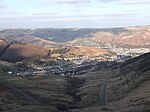Pantysgallog (Low Level) Halt railway station
1914 establishments in Wales1958 disestablishments in WalesDisused railway stations in Merthyr Tydfil County BoroughFormer London and North Western Railway stationsPages with no open date in Infobox station ... and 4 more
Railway stations in Great Britain closed in 1958Railway stations in Great Britain opened in 1914Use British English from May 2021Wales railway station stubs
Pantysgallog Low Level Halt railway station was a station that served the village of Pant, Merthyr Tydfil, Wales on the Merthyr, Tredegar and Abergavenny Railway. The station closed in 1958 and the site is now a housing estate.
Excerpt from the Wikipedia article Pantysgallog (Low Level) Halt railway station (License: CC BY-SA 3.0, Authors).Pantysgallog (Low Level) Halt railway station
Jones Street,
Geographical coordinates (GPS) Address Nearby Places Show on map
Geographical coordinates (GPS)
| Latitude | Longitude |
|---|---|
| N 51.770189 ° | E -3.353635 ° |
Address
Jones Street
Jones Street
CF48 2AH , Pant
Wales, United Kingdom
Open on Google Maps






